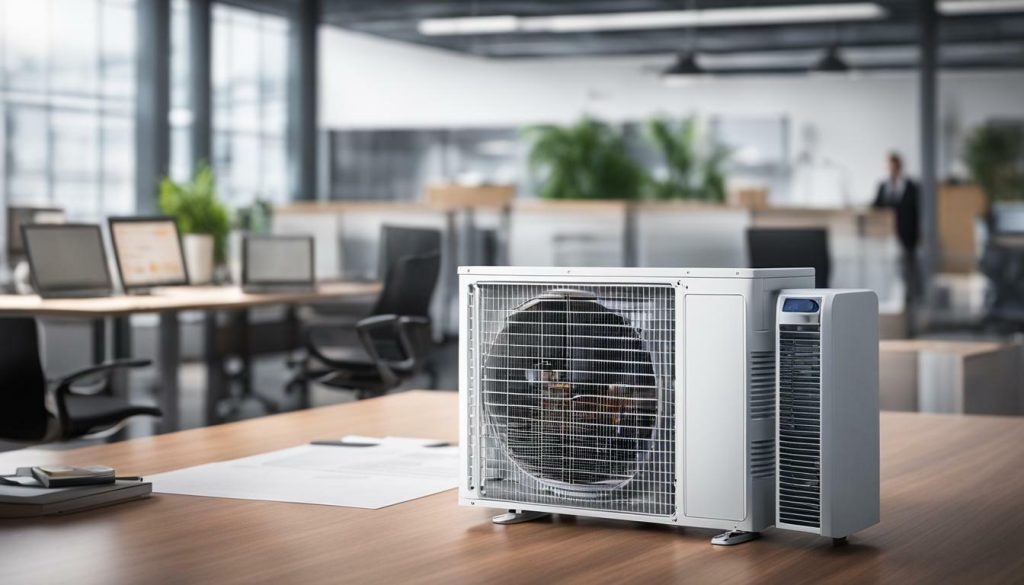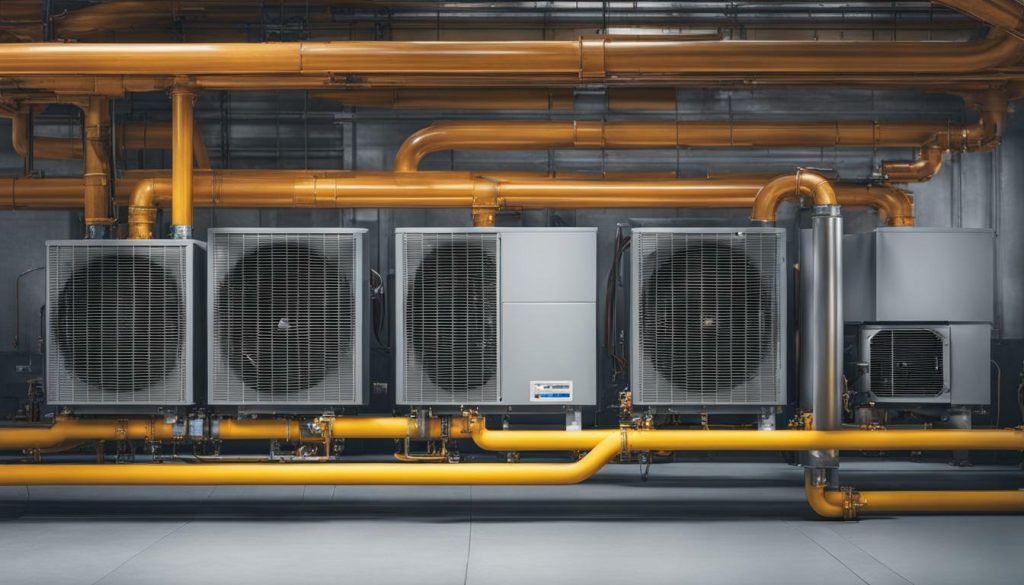Writing HVAC proposals requires a strategic approach to showcase your company’s unique advantages and persuade potential clients. A well-crafted proposal can play a crucial role in converting prospects into loyal customers. By following certain key elements and utilizing effective techniques, you can create compelling proposals that leave a lasting impression.
Key Takeaways:
- Utilize HVAC proposal templates to streamline the writing process and ensure professionalism.
- Create an attention-grabbing introduction that personalizes the content and captures the client’s interest.
- Showcase your company’s unique advantages to differentiate yourself from competitors.
- Understand customer needs and tailor your proposal to address their specific pain points.
- Highlight the importance of environmental friendliness and energy efficiency in the HVAC industry.
Now that we have set the foundation, let’s delve into the specific details of writing compelling HVAC proposals that have the power to convert prospects.
The Benefits of Using HVAC Proposal Templates
HVAC proposal templates can significantly simplify the process of writing proposals and ensure a professional presentation. These templates provide a structured framework that includes all the necessary sections and elements required for a comprehensive proposal. By using a template, you can save time and effort by focusing on customizing the content rather than starting from scratch.
One of the key benefits of using HVAC proposal templates is consistency. Templates help maintain a consistent format and style across all proposals, which enhances your brand image and professionalism. With predefined sections for project scope, pricing, terms and conditions, and more, templates ensure that all essential information is included, minimizing the chances of overlooking important details.
Another advantage is efficiency. Proposal templates enable you to streamline the writing process by eliminating repetitive tasks. You can easily insert boilerplate content and customize it to fit the specific project requirements. This saves valuable time and allows you to focus on tailoring the proposal to the client’s needs and preferences.
Moreover, HVAC proposal templates offer flexibility. They can be adapted to different types of projects and clients, making it easier to create personalized proposals. Whether you’re bidding on a residential HVAC installation or a commercial maintenance contract, templates can be modified to showcase the unique advantages and expertise of your company.

| Benefits of Using HVAC Proposal Templates | |
|---|---|
| Consistency | Templates ensure a consistent format and style. |
| Efficiency | Saves time by eliminating repetitive tasks. |
| Flexibility | Templates can be adapted to different project types. |
By leveraging HVAC proposal templates, you can streamline the proposal writing process, ensure professionalism, and increase your chances of converting prospects into satisfied customers. Take advantage of these templates to create persuasive and comprehensive proposals that effectively communicate your value proposition and expertise.
Crafting an Attention-Grabbing Introduction
The introduction of your HVAC proposal sets the stage for persuading potential clients and should immediately grab their attention. It is your chance to make a memorable first impression and showcase your professionalism. By following these tips, you can create an introduction that leaves a lasting impact on your prospects.
Personalize the Content
One of the most effective ways to grab your client’s attention is to tailor the introduction to their specific needs and pain points. Research your potential client and understand their challenges. Use this knowledge to demonstrate that you understand their unique situation and can offer a solution. By showing that you genuinely care about their needs, you will captivate their interest and increase the chances of converting them into a customer.
Make It Memorable
An attention-grabbing introduction should be memorable and stand out from the competition. Consider incorporating an interesting fact, statistic, or compelling story related to the HVAC industry. This will not only intrigue your prospects but also help establish your expertise and credibility. Additionally, use strong and persuasive language that conveys confidence and professionalism. Remember, the goal is to leave a lasting impression that makes your proposal stick in the client’s mind.

Highlight the Benefits
Finally, emphasize the benefits of choosing your company for their HVAC needs. Clearly articulate how your services can solve their specific problems, save them time and money, and enhance their overall comfort and satisfaction. Use bullet points or a table to present the benefits in a visually appealing and easy-to-read format. This will make it easier for your prospects to understand the value you bring and encourage them to continue reading your proposal.
| Benefits of Choosing Us: |
|---|
| Reliable and prompt service |
| Experienced and knowledgeable technicians |
| Customized solutions tailored to your needs |
| Competitive pricing |
| Exceptional customer service |
By crafting an attention-grabbing introduction that is personalized, memorable, and highlights the benefits of choosing your company, you can significantly increase the chances of converting prospects into loyal customers. Remember to continue this persuasive tone throughout the rest of your proposal, providing detailed information on the services you offer, testimonials from satisfied customers, and a clear contract that outlines the terms and conditions of your partnership.
Showcasing Your Unique Advantages
Differentiating your HVAC business from competitors is crucial in persuading prospects, and the proposal is the perfect platform to showcase your unique advantages. Highlighting your strengths and demonstrating why your company is the best choice can make a significant impact on the client’s decision-making process.
- Quality of Service: Clearly communicate your commitment to providing exceptional service. List any certifications, industry affiliations, or awards that demonstrate your expertise and professionalism.
- Experience and Expertise: Share details about the years of experience your company has in the HVAC industry. Outline specific projects or clients you have successfully served, along with testimonials if available.
- Innovative Solutions: Showcase any unique approaches or technologies that set your HVAC business apart. Explain how these innovations can benefit the client and address their specific needs.
- Customer Satisfaction: Include positive reviews and testimonials from satisfied customers. These endorsements can instill trust and confidence in potential clients and provide proof of your company’s exceptional service.
Remember to tailor your unique advantages to the specific needs and pain points of the client. By effectively showcasing what makes your HVAC business exceptional, you can increase your chances of converting prospects into loyal customers.

| Advantage | Description |
|---|---|
| Quality of Service | Emphasize your commitment to providing exceptional service by highlighting relevant certifications, industry affiliations, and awards. |
| Experience and Expertise | Showcase your years of experience in the HVAC industry and provide examples of successful projects or satisfied clients. |
| Innovative Solutions | Demonstrate any unique approaches or technologies your company utilizes to deliver superior HVAC solutions. |
| Customer Satisfaction | Include positive reviews and testimonials from satisfied customers to build trust and credibility with potential clients. |
Understanding Customer Needs
A successful HVAC proposal demonstrates a deep understanding of the customer’s needs and offers tailored solutions to address their pain points. By conducting thorough research and analysis, you can gather valuable insights that will enable you to craft a proposal that resonates with your target audience.
Start by identifying the specific challenges and requirements that your potential customer may face. This could involve conducting interviews, surveys, or analyzing data to gain a comprehensive understanding of their needs. By doing so, you can align your proposal with their goals and objectives.
Once you have gathered the necessary information, it is important to clearly communicate how your HVAC services will meet their unique needs. Use language that reflects their pain points and offers solutions that are specific to their situation. This will show the client that you have taken the time to understand their challenges and have developed a customized plan to address them.
Table: Key Steps in Understanding Customer Needs
| Step | Description |
|---|---|
| Research | Conduct interviews, surveys, and data analysis to gain insights into the customer’s challenges and requirements. |
| Identify Pain Points | Determine the specific pain points and challenges that the customer is facing in their HVAC systems. |
| Propose Tailored Solutions | Create a customized plan that addresses the customer’s unique needs and provides solutions to their pain points. |
| Communicate Effectively | Use clear and concise language to explain how your HVAC services will meet the customer’s needs and solve their problems. |
By taking the time to understand your customer’s needs and tailor your proposal accordingly, you can demonstrate your expertise and establish trust. This will significantly increase your chances of winning the project and converting prospects into satisfied customers.

Focusing on Environmental Friendliness
In today’s eco-conscious world, highlighting your HVAC business’s commitment to sustainability and energy efficiency can significantly enhance your proposal’s persuasiveness. Incorporating environmental friendliness into your proposal demonstrates your dedication to reducing carbon footprint and providing eco-friendly solutions to clients.
Start by showcasing how your company implements sustainable practices in its operations and installations. Mention any certifications or affiliations with green organizations that validate your commitment to the environment. This can include certifications like LEED or affiliations with organizations promoting energy-efficient solutions.
Furthermore, emphasize the use of energy-efficient HVAC systems and technologies in your proposal. Highlight the benefits of these systems, such as reduced energy consumption, lower utility bills, and a smaller environmental impact. Provide data and statistics that support the effectiveness and cost savings of energy-efficient solutions.
Table 1: Benefits of Energy-Efficient HVAC Systems
| Benefits | Explanation |
|---|---|
| Lower Energy Consumption | Energy-efficient systems use less energy, leading to reduced utility expenses. |
| Lower Environmental Impact | By using less energy, these systems contribute to a smaller carbon footprint and help combat climate change. |
| Improved Indoor Air Quality | Energy-efficient systems ensure better filtration and ventilation, resulting in cleaner and healthier indoor air. |
| Longer Lifespan | These systems are designed for durability and longevity, reducing the need for frequent replacements. |
To further appeal to environmentally conscious clients, consider offering eco-friendly maintenance programs. Provide information on eco-conscious maintenance practices, such as regular filter changes, system inspections, and proper disposal of HVAC components. Emphasize the importance of preventive maintenance in optimizing system performance and reducing energy waste.
By incorporating environmental friendliness into your HVAC proposal, you demonstrate your dedication to sustainable practices, attract eco-conscious clients, and differentiate your business from competitors. Remember to tailor your proposal to each client’s specific needs and pain points, highlighting how your energy-efficient solutions can address their requirements and contribute to a greener future.

Including Reviews and Testimonials in Your HVAC Proposal
Including reviews and testimonials from satisfied customers adds credibility and trustworthiness to your HVAC proposal. When potential clients see positive feedback from others who have already worked with your company, they are more likely to have confidence in your services. Positive reviews and testimonials act as social proof, showcasing the quality of your work and the satisfaction of previous clients.
One effective way to include reviews and testimonials in your HVAC proposal is to create a dedicated section highlighting the experiences of your satisfied customers. You can showcase specific projects and the positive outcomes achieved, emphasizing the value you can bring to potential clients. This section can include brief quotes or excerpts from customer testimonials, along with their names and the services they received.
Additionally, consider incorporating visual elements into your proposal to further enhance the impact of reviews and testimonials. You can include images of completed projects or before-and-after comparisons to visually demonstrate the success stories of your previous clients. By combining written testimonials with visual evidence, you can create a powerful presentation that convinces prospects to choose your HVAC services.
Table: Customer Testimonials
| Client Name | Service Provided | Testimonial |
|---|---|---|
| John Smith | AC Installation | “Working with ABC HVAC was a great experience. They were professional, efficient, and exceeded my expectations. My new AC system works flawlessly, and I highly recommend their services.” |
| Jane Doe | Heating Repair | “I called XYZ HVAC for an emergency heating repair, and they were quick to respond. Their technician arrived promptly, identified the issue, and fixed it in no time. I was impressed with their expertise and friendly service.” |
By including reviews and testimonials in your HVAC proposal, you can establish trust, showcase your expertise, and differentiate your company from competitors. Remember to regularly collect feedback from satisfied customers to continuously enhance your reputation and strengthen your proposals.

Creating a Clear Contract
A well-defined contract in your HVAC proposal ensures transparency and avoids any misunderstandings between you and the client. It serves as a legally binding agreement that outlines the services you will provide, the associated costs, timelines, and terms and conditions of the project.
When creating a contract, it’s crucial to clearly state the scope of work, including the specific HVAC services you will perform, such as installation, repairs, or maintenance. Use bullet points or tables to present this information in a concise and easily understandable format.
Additionally, include a breakdown of the costs involved, specifying the pricing for materials, labor, and any additional charges. This will help your client understand the financial aspects of the proposal and make an informed decision. Make sure to clearly state the payment terms, such as the due dates and acceptable payment methods.
| Service | Cost |
|---|---|
| HVAC Installation | $5,000 |
| HVAC Repairs | $100 per hour |
| Maintenance Plan | $500 annually |
Furthermore, clearly outline the project timeline, including the estimated start and completion dates. This will set expectations for both parties and ensure that the project progresses smoothly.
To add credibility and gain the client’s trust, consider including any warranties or guarantees offered by your company. This will provide the client with reassurance that they are making a wise investment in your HVAC services.
By creating a clear and comprehensive contract, you demonstrate your professionalism, attention to detail, and commitment to delivering high-quality HVAC services. Utilize proposal software or templates to streamline the process and enhance the overall presentation of your proposal. Remember, a well-structured contract is key to securing successful projects and long-term client relationships.

Conclusion
Crafting compelling HVAC proposals is essential for converting prospects into loyal customers, and by following the tips and utilizing proposal templates, you can increase your chances of success. A well-crafted proposal not only showcases your company’s unique advantages but also persuades potential clients to choose your services. By using HVAC proposal templates, you can streamline the proposal writing process and ensure a professional presentation.
The introduction of your proposal plays a crucial role in capturing the client’s attention. Personalize the content to make a memorable first impression and highlight how your services can meet their specific needs. Remember to focus on the customer’s pain points and emphasize how your business can provide effective solutions.
Furthermore, incorporating environmental friendliness into your proposal is increasingly important in today’s market. Highlight your commitment to sustainability and energy efficiency to appeal to eco-conscious clients. By demonstrating your dedication to reducing environmental impact, you can set yourself apart from competitors and attract clients who prioritize green solutions.
Reviews and testimonials are powerful tools for building trust and credibility. Include positive feedback from satisfied customers in your HVAC proposal to showcase your track record of delivering exceptional service. This social proof can greatly influence potential clients’ decision-making process and increase their confidence in your business.
Lastly, a clear contract is essential for ensuring shared expectations and protecting both parties’ interests. Outline the scope of services, prices, timelines, and all terms and conditions in a concise and transparent manner. Utilize proposal software to enhance the presentation, track customer engagement, and simplify the contract creation process.
By following these tips and utilizing proposal templates, you can create compelling HVAC proposals that effectively convert prospects into loyal customers. Take the time to understand your clients’ needs, highlight your unique advantages, and present a comprehensive proposal that addresses their pain points. With a well-crafted proposal, you can increase your chances of winning new business and establishing long-lasting customer relationships.
FAQ
Why are compelling HVAC proposals important for businesses?
Compelling HVAC proposals are essential for businesses to succeed as they can effectively showcase the company’s unique advantages, persuade potential clients, and outline the conditions of cooperation.
How can HVAC proposal templates benefit businesses?
HVAC proposal templates can streamline the proposal writing process and ensure professionalism. They provide a structured format for presenting information and can be customized to fit the business’s specific needs.
What is the key to crafting an attention-grabbing introduction in an HVAC proposal?
Personalizing the content and making a memorable first impression are crucial in crafting an attention-grabbing introduction. Capturing the client’s attention from the beginning sets the tone for the rest of the proposal.
How can businesses showcase their unique advantages in an HVAC proposal?
Businesses can showcase their unique advantages by highlighting their expertise, experience, and any specialized services or technologies they offer. Providing concrete examples and demonstrating how these advantages benefit the client are also effective strategies.
Why is it important to understand customer needs when writing an HVAC proposal?
Understanding customer needs helps tailor the proposal to address specific pain points and demonstrate how the business can meet those needs. It shows the client that the business has taken the time to understand their unique requirements.
How can businesses incorporate environmental friendliness into their HVAC proposals?
Businesses can incorporate environmental friendliness by emphasizing sustainable practices, energy-efficient solutions, and eco-friendly products. By showcasing a commitment to the environment, businesses can appeal to clients who prioritize sustainability.
Should businesses include reviews and testimonials in their HVAC proposals?
Yes, including reviews and testimonials in HVAC proposals can boost credibility and trust. Positive feedback from satisfied customers serves as social proof and demonstrates the business’s ability to deliver quality services.
What elements should be included in a clear contract within an HVAC proposal?
A clear contract should include details such as the scope of services, pricing, project timelines, payment terms, and any relevant terms and conditions. Ensuring clarity and transparency in the contract helps avoid misunderstandings and disputes.





0 Comments